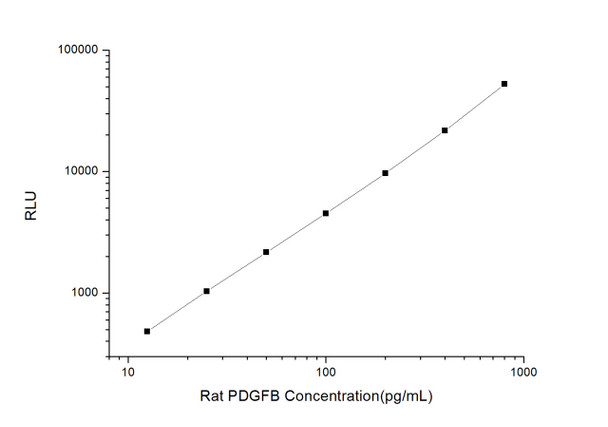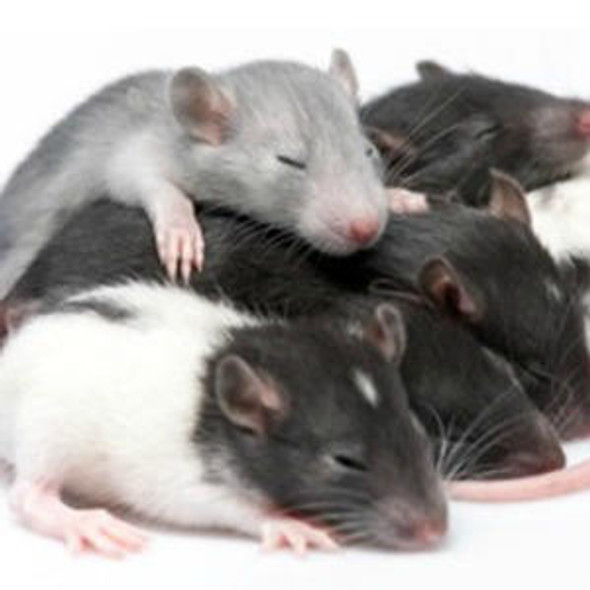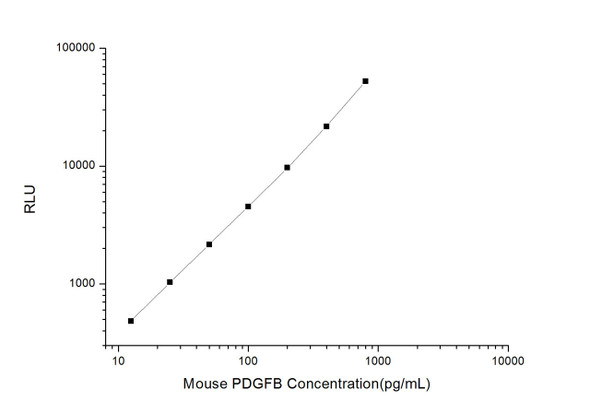Rat Signaling ELISA Kits 3
Rat PDGFB (Platelet Derived Growth Factor Subunit B) CLIA Kit (RTES00449)
- SKU:
- RTES00449
- Product Type:
- ELISA Kit
- ELISA Type:
- CLIA Kit
- Size:
- 96 Assays
- Sensitivity:
- 7.5pg/mL
- Range:
- 12.5-800pg/mL
- ELISA Type:
- Sandwich
- Reactivity:
- Rat
- Sample Type:
- Serum, plasma and other biological fluids
Description
| Assay type: | Sandwich |
| Format: | 96T |
| Assay time: | 4.5h |
| Reactivity: | Rat |
| Detection method: | Chemiluminescence |
| Detection range: | 12.50-800 pg/mL |
| Sensitivity: | 7.50 pg/mL |
| Sample volume: | 100µL |
| Sample type: | Serum, plasma and other biological fluids |
| Repeatability: | CV < 15% |
| Specificity: | This kit recognizes Rat PDGFB in samples. No significant cross-reactivity or interference between Rat PDGFB and analogues was observed. |
This kit uses Sandwich-CLIA as the method. The micro CLIA plate provided in this kit has been pre-coated with an antibody specific to Rat PDGF-B. Standards or samples are added to the appropriate micro CLIA plate wells and combined with the specific antibody. Then a biotinylated detection antibody specific for Rat PDGF-B and Avidin-Horseradish Peroxidase (HRP) conjugate are added to each micro plate well successively and incubated. Free components are washed away. The substrate solution is added to each well. Only those wells that contain Rat PDGF-B, biotinylated detection antibody and Avidin-HRP conjugate will appear fluorescence. The Relative light unit (RLU) value is measured spectrophotometrically by the Chemiluminescence immunoassay analyzer. The RLU value is positively associated with the concentration of Rat PDGF-B. The concentration of Rat PDGF-B in the samples can be calculated by comparing the RLU of the samples to the standard curve.
| UniProt Protein Function: | PDGFB: Growth factor that plays an essential role in the regulation of embryonic development, cell proliferation, cell migration, survival and chemotaxis. Potent mitogen for cells of mesenchymal origin. Required for normal proliferation and recruitment of pericytes and vascular smooth muscle cells in the central nervous system, skin, lung, heart and placenta. Required for normal blood vessel development, and for normal development of kidney glomeruli. Plays an important role in wound healing. Signaling is modulated by the formation of heterodimers with PDGFA. A chromosomal aberration involving PDGFB is found in dermatofibrosarcoma protuberans. Translocation t(17;22)(q22;q13) with PDGFB. Belongs to the PDGF/VEGF growth factor family. |
| UniProt Protein Details: | Protein type:Secreted; Oncoprotein; Secreted, signal peptide; Motility/polarity/chemotaxis Cellular Component: basolateral plasma membrane; cell soma; cell surface; cytoplasm; dendrite; extracellular space; intracellular; membrane Molecular Function:chemoattractant activity; collagen binding; growth factor activity; identical protein binding; platelet-derived growth factor binding; platelet-derived growth factor receptor binding; protein heterodimerization activity; protein homodimerization activity; receptor binding; superoxide-generating NADPH oxidase activator activity Biological Process: actin cytoskeleton organization and biogenesis; activation of protein kinase activity; activation of protein kinase B; blood vessel morphogenesis; cell growth; cell projection biogenesis; DNA replication; embryonic placenta development; eye photoreceptor cell development; glial cell development; heart development; hemopoiesis; monocyte chemotaxis; negative regulation of cell migration; negative regulation of phosphatidylinositol biosynthetic process; negative regulation of protein binding; negative regulation of transcription, DNA-dependent; neuron remodeling; peptidyl-serine phosphorylation; peptidyl-tyrosine phosphorylation; platelet-derived growth factor receptor signaling pathway; positive chemotaxis; positive regulation of blood vessel endothelial cell migration; positive regulation of cell migration; positive regulation of cell proliferation; positive regulation of chemotaxis; positive regulation of collagen biosynthetic process; positive regulation of cyclin-dependent protein kinase activity; positive regulation of DNA replication; positive regulation of endothelial cell proliferation; positive regulation of fibroblast growth factor receptor signaling pathway; positive regulation of fibroblast proliferation; positive regulation of glomerular filtration; positive regulation of MAP kinase activity; positive regulation of MAPKKK cascade; positive regulation of mitosis; positive regulation of mitotic cell cycle, embryonic; positive regulation of peptidyl-tyrosine phosphorylation; positive regulation of phosphoinositide 3-kinase activity; positive regulation of phosphoinositide 3-kinase cascade; positive regulation of protein amino acid autophosphorylation; positive regulation of smooth muscle cell migration; positive regulation of smooth muscle cell proliferation; positive regulation of transcription, DNA-dependent; protein amino acid phosphorylation; regulation of cell proliferation; regulation of peptidyl-tyrosine phosphorylation; response to axon injury; response to drug; response to estradiol stimulus; response to estrogen stimulus; response to hypoxia; response to insulin stimulus; response to organic cyclic substance; response to organic substance; response to wounding; retina development in camera-type eye; substrate-bound cell migration; synaptogenesis; wound healing |
| NCBI Summary: | may play a role in carotid artery smooth muscle cell proliferation and neointimal formation in response to balloon catheter injury [RGD, Feb 2006] |
| UniProt Code: | Q05028 |
| NCBI GenInfo Identifier: | 158081747 |
| NCBI Gene ID: | 24628 |
| NCBI Accession: | NP_113712. 1 |
| UniProt Related Accession: | Q05028 |
| Molecular Weight: | 25,603 Da |
| NCBI Full Name: | platelet-derived growth factor subunit B |
| NCBI Synonym Full Names: | platelet derived growth factor subunit B |
| NCBI Official Symbol: | Pdgfb |
| NCBI Official Synonym Symbols: | SIS; c-sis |
| NCBI Protein Information: | platelet-derived growth factor subunit B |
| UniProt Protein Name: | Platelet-derived growth factor subunit B |
| UniProt Synonym Protein Names: | PDGF-2; Platelet-derived growth factor B chain; Platelet-derived growth factor beta polypeptide |
| Protein Family: | Platelet-derived growth factor |
| UniProt Gene Name: | Pdgfb |
| UniProt Entry Name: | PDGFB_RAT |
As the RLU values of the standard curve may vary according to the conditions of the actual assay performance (e. g. operator, pipetting technique, washing technique or temperature effects), the operator should establish a standard curve for each test. Typical standard curve and data is provided below for reference only.
| Concentration (pg/mL) | RLU | Average | Corrected |
| 800 | 48120 57164 | 52642 | 52616 |
| 400 | 19823 23645 | 21734 | 21708 |
| 200 | 10176 9240 | 9708 | 9682 |
| 100 | 4201 4903 | 4552 | 4526 |
| 50 | 2240 2136 | 2188 | 2162 |
| 25 | 1125 995 | 1060 | 1034 |
| 12.50 | 507 511 | 509 | 483 |
| 0 | 25 27 | 26 | -- |
Precision
Intra-assay Precision (Precision within an assay): 3 samples with low, mid range and high level Rat PDGFB were tested 20 times on one plate, respectively.
Inter-assay Precision (Precision between assays): 3 samples with low, mid range and high level Rat PDGFB were tested on 3 different plates, 20 replicates in each plate.
| Intra-assay Precision | Inter-assay Precision | |||||
| Sample | 1 | 2 | 3 | 1 | 2 | 3 |
| n | 20 | 20 | 20 | 20 | 20 | 20 |
| Mean (pg/mL) | 37.42 | 82.57 | 383.97 | 38.51 | 87.49 | 388.90 |
| Standard deviation | 3.92 | 9.48 | 31.83 | 4.18 | 9.41 | 24.00 |
| C V (%) | 10.48 | 11.48 | 8.29 | 10.85 | 10.76 | 6.17 |
Recovery
The recovery of Rat PDGFB spiked at three different levels in samples throughout the range of the assay was evaluated in various matrices.
| Sample Type | Range (%) | Average Recovery (%) |
| Serum (n=5) | 100-113 | 107 |
| EDTA plasma (n=5) | 96-110 | 103 |
| Cell culture media (n=5) | 92-106 | 97 |
Linearity
Samples were spiked with high concentrations of Rat PDGFB and diluted with Reference Standard & Sample Diluent to produce samples with values within the range of the assay.
| Serum (n=5) | EDTA plasma (n=5) | Cell culture media (n=5) | ||
| 1:2 | Range (%) | 95-106 | 95-112 | 96-109 |
| Average (%) | 100 | 103 | 103 | |
| 1:4 | Range (%) | 92-107 | 88-101 | 94-107 |
| Average (%) | 99 | 93 | 99 | |
| 1:8 | Range (%) | 103-115 | 87-100 | 85-96 |
| Average (%) | 109 | 93 | 90 | |
| 1:16 | Range (%) | 102-115 | 87-99 | 90-105 |
| Average (%) | 108 | 92 | 97 |
An unopened kit can be stored at 4°C for 1 month. If the kit is not used within 1 month, store the items separately according to the following conditions once the kit is received.
| Item | Specifications | Storage |
| Micro CLIA Plate(Dismountable) | 8 wells ×12 strips | -20°C, 6 months |
| Reference Standard | 2 vials | |
| Concentrated Biotinylated Detection Ab (100×) | 1 vial, 120 µL | |
| Concentrated HRP Conjugate (100×) | 1 vial, 120 µL | -20°C(shading light), 6 months |
| Reference Standard & Sample Diluent | 1 vial, 20 mL | 4°C, 6 months |
| Biotinylated Detection Ab Diluent | 1 vial, 14 mL | |
| HRP Conjugate Diluent | 1 vial, 14 mL | |
| Concentrated Wash Buffer (25×) | 1 vial, 30 mL | |
| Substrate Reagent A | 1 vial, 5 mL | 4°C (shading light) |
| Substrate Reagent B | 1 vial, 5 mL | 4°C (shading light) |
| Plate Sealer | 5 pieces | |
| Product Description | 1 copy | |
| Certificate of Analysis | 1 copy |
- Set standard, test sample and control (zero) wells on the pre-coated plate and record theirpositions. It is recommended to measure each standard and sample in duplicate. Note: addall solutions to the bottom of the plate wells while avoiding contact with the well walls. Ensuresolutions do not foam when adding to the wells.
- Aliquot 100µl of standard solutions into the standard wells.
- Add 100µl of Sample / Standard dilution buffer into the control (zero) well.
- Add 100µl of properly diluted sample (serum, plasma, tissue homogenates and otherbiological fluids. ) into test sample wells.
- Cover the plate with the sealer provided in the kit and incubate for 90 min at 37°C.
- Aspirate the liquid from each well, do not wash. Immediately add 100µL of BiotinylatedDetection Ab working solution to each well. Cover the plate with a plate seal and gently mix. Incubate for 1 hour at 37°C.
- Aspirate or decant the solution from the plate and add 350µL of wash buffer to each welland incubate for 1-2 minutes at room temperature. Aspirate the solution from each well andclap the plate on absorbent filter paper to dry. Repeat this process 3 times. Note: a microplatewasher can be used in this step and other wash steps.
- Add 100µL of HRP Conjugate working solution to each well. Cover with a plate seal andincubate for 30 min at 37°C.
- Aspirate or decant the solution from each well. Repeat the wash process for five times asconducted in step 7.
- Add 100µL of Substrate mixture solution to each well. Cover with a new plate seal andincubate for no more than 5 min at 37°C. Protect the plate from light.
- Determine the RLU value of each well immediately.






